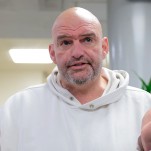The Crappy Age Gap Between Leading Men and Female Love Interests
LatestHey, you know this shit where we systematically treat all women who are not Helen Mirren like untouchable garbage as soon as they hit 40? It’s a problem. We see it in sitcoms, where uniformly schlubby husbands bed uniformly “hot” wives. We see it on reality TV, where older women who dare to express sexuality are mocked as predatory and absurd “cougars.” We see it in the ‘bloidz, where every single cellulite dimple on every single famous bun is tagged, catalogued, and filed away by a fusty British librarian. And we especially see it in Hollywood, where leading men get older and older, but leading ladies stay the same age. All right all right all right.
Vulture put together some brilliant little infographics tracking the relative ages of male movie stars and their female love interests. Unsurprisingly, because this is how time works, the leading men get older at a steady rate (and remain leading men). The women they’re fucking, however, stay the same age—around 29.
Some actors’ age gaps are more persistently egregious than others. Johnny Depp had multiple on-screen partners who were under 20 when he was gaining on 40. Liam Neeson, 63, will be going to town on Olivia Wilde, 29, in Third Person this year—a 34-year age difference (high-five, bro!!!). Richard Gere, also 63, and Laetitia Casta, 34, bridged a similar gap in 2012’s Arbitrage. At the other end of the spectrum, Tom Hanks’s female counterparts have remained reliably within a decade of his age (attributable, I’d wager, to the fact that Hanks typically plays cuddly dad types rather than virile sex-having types). Here’s Vulture’s analysis of the Liam Neeson chart:
-

-

-

-

-

-

-

-

-

-

-

-

-

-

-

-

-

-

-

-

-

-

-

-

-

-

-

-

-

-

-

-

-

-

-

-

-

-

-

-








































